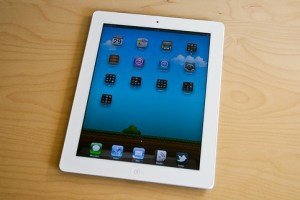
When Apple released its third-quarter 2011 earnings results today the numbers were, as is becoming almost customary for the Cupertino crew lately, a huge blow-out. Success was spread over many parts of the business, particularly the company’s flagship products, the iPhone and the Mac. Both are growing and show that Apple is on a tear with the entirety of its business. But those iPad results? Those were fairly stunning.
While Android phones are outpacing the iPhone in market share, it’s clear that Apple is not anywhere close to giving up its lead in the tablet race. And despite the seemingly endless train of new tablets popping up, Apple is putting more space between its tablet and the rest of the field.
Here are the most important numbers from Apple’s earnings that show that the iPad is seemingly unstoppable, and clearly Apple’s most important product.
$6 billion: That’s how much money Apple made from the iPad just in April, May, and June of this year. The key is that Apple now makes more money off the iPad, a slightly more than a year old product, than its Mac lineup. Apple pulled in just under $5 billion in revenue from Mac desktops and notebooks during the same quarter.
The people scooping up iPads are not just gadget hounds and consumers with expendable income. Buyers include large corporations who are handing them out to employees to help them do their job, something Apple has been actively pushing for a while. But Apple is also getting a boost in iPad sales even from sources the company didn’t anticipate.
“We sold more iPads to K-12 [schools] than we did Macs, which is absolutely shocking,” said Apple COO Tim Cook on a conference call with analysts today. “We never would have predicted that.”
“Shocking,” perhaps. But probably not unwelcome. Apple very likely doesn’t mind getting kids used to working on iPads in elementary school.
9.25 million: That’s how many iPads Apple sold during the quarter. That blows away what Apple sold a year ago, just 3.3 million iPads, or a 183 percent bump. So what’s changed in the last quarter? Apple’s obviously had more than a year to advertise the product and build a customer base. But an important step is that Apple’s gotten its iPad supply-chain act together. If you’ll recall the situation a year ago, the original iPad was extremely hard to find. Last year Apple didn’t catch up on the seemingly insatiable demand for the original iPad until later in the summer.
Apple admitted earlier this year it couldn’t make iPad 2s fast enough to keep up with demand. Now, Apple is still selling “every iPad 2 it makes,” but also said it was able to make more iPads 2s during the most recent quarter than it did in the same period a year ago. So while demand is still ahead of supply (“Sales of the iPad 2 have been absolutely a frenzy,” said Cook), they’re getting closer to meeting it. Cook went as far as to say that in some markets they had actually caught up and were able to be in some sort of an equilibrium with demand and supply. He did not, however, expand on which markets.
14 percent: That’s actually not an iPad number. That’s how much Mac sales grew durng this most recent quarter compared to the same quarter a year ago. While iPads are outgrowing Macs, they’re doing it without significantly affecting the Mac business.
Sure, Cook allowed, “we do believe that some customers chose ot purchase an iPad instead of a new Mac during the quarter. But we also believe that even more customers purchased n iPad over a Windows PC. There’s a lot more of the PC business to cannibalize over the Mac.”
Apple has been banging the “post-PC” drum pretty hard since it introduced the iPad, and at least some of its tablet competitors are selling the tablet as a PC in a different form factor. Surging iPad sales in addition to steadily growing Mac sales could mean that Apple customers are buying into Apple’s view of the computing world too.
222 million: That’s the total number of iOS-based devices that are floating around in people’s pockets, purses, and briefcases: iPhones, iPads, and iPod Touches. That’s compared to 130 million Android devices that Google recently announced. While the iPhone has a three-year headstart on the iPad, it’s clear that Apple’s tablet is pushing those numbers up.
$2.5 billion: Money Apple paid back to developers whose apps sold through its store so far. That, along with the previous iOS device tally, are really meant to be siren calls for developers.
The number of iOS devices, representing the continued viability of the iPhone as a platform for selling your apps and the growth of the iPad, are numbers Apple likes to remind app makers of regularly. It’s a strategy to let those who are or might be attracted to the growing number of Android gadgets floating around that not only is iOS continuing to grow, it’s also good for business.
Photo courtesy of Flickr user William Hook
Related research and analysis from GigaOM Pro:
Subscriber content. Sign up for a free trial.
- Mobile Q1: All Eyes on Tablets, T-Mobile and ATT
- A Media Tablet Forecast, 2011 – 2015
- Why iPad 2 Will Lead Consumers Into the Post-PC Era
Article source: GigOM http://feedproxy.google.com/~r/OmMalik/~3/nA_sfCedJkA/